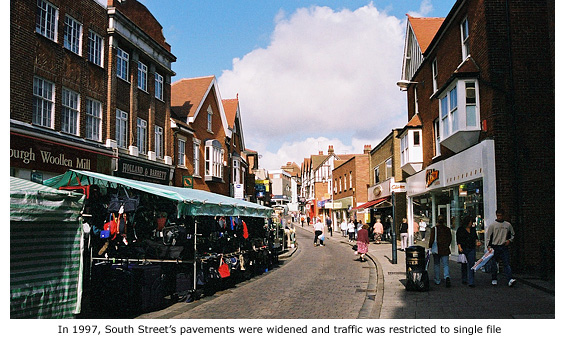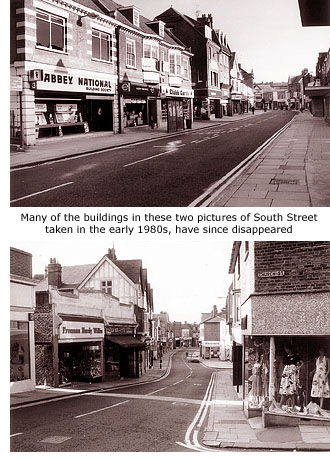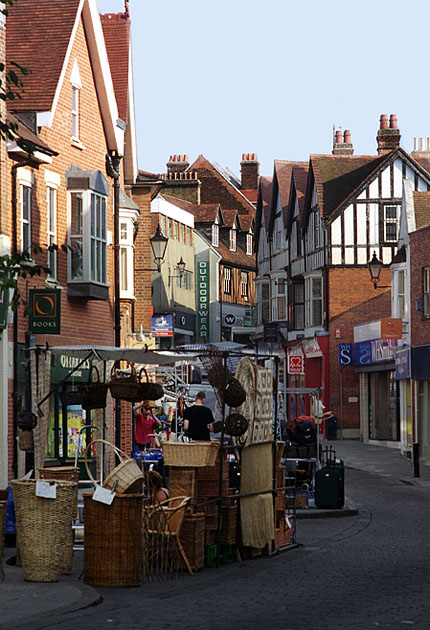|
There can be little doubt that the geographical direction of this road made South Street the natural choice of name long before it was designated as such in the 13th century. Originally a continuation of the Old Stortford Road (now Southmill Road) it was, for centuries, the only direct entrance into the town from the south, and a principal route to East Anglia via Bishop’s Stortford’s thriving market.
When a long distance coach service began running from London to Bishop’s Stortford in the 17th century, the town’s popularity increased ten-fold and inevitably led to the development of many new service facilities – mainly inns and ale houses. As a consequence, the narrow and predominantly residential South Street became a busy and congested highway.
But the town’s new found wealth was short lived. After the Hockerill bypass was built in 1670 (See Guide 12), most stagecoach owners avoided the busy town centre all together. Their decision brought wealth and fame to the inns of Hockerill, but economic gloom to the town and the eventual demise of many hostelries.
A further blow to its economy came in 1749, when the Essex and Herts Highways Trust ruled that the entire length of North Street and South Street should be widened to 20ft (6m). The reality of this was that virtually all buildings on the eastern side of both roads were demolished. Rebuilding obviously took place, but because the town's commercial centre was based around the Market Square and Potter Street, most new properties built were for residential use. Not until the opening of the Stort Navigation in 1769 did the town’s commerce and malting industry fully recover.
All important to the maltsers was easy access to river transport, and many maltings were built close to its banks as well as in South Street itself, linked to the river by a series of lanes and alleyways. Most of these still survive, two of the larger lanes now named Riverside Walk and The Dells.
|
|

As the town’s popularity and population grew in the 19th and early 20th century, many of the houses in South Street were converted to shops selling a wide range of commodities. In the 1930s, property developers and business men also began to take a keen interest in the street and by the 1950s its full potential had been realised, becoming the town’s main shopping centre. But the most dramatic change in Bishop’s Stortford’s long history came in the late 1960s and early 70s when the Town Redevelopment Scheme was implimented.
Nationally it was a time of regeneration and rebuilding, where modernism and functionality prevailed and anything deemed to be 'old' was liable to be swept away on a tide of new development and planning. Locally, some redevelopment was certainly necessary, and justified, but on reflection much of the destruction that took place now seems like wilful vandalism, aided and abetted by small, ‘get-rich-quick’ developers whose ugly ‘functional’ structures were totally out of place alongside their elderly and more traditional neighbours. Unfortunately, Bishop’s Stortford still bears the scars of this period, the results of which can be clearly seen in South Street’s diverse building styles.
 The town centre was the subject of yet more change in 1997 when the section of South Street between Station Road and Bridge Street was torn up and a new thoroughfare created. This time, however, it was to everyone's benefit. Market traders, long restricted to just North Street and Market Square were allotted extra space, traffic was restricted to single file, and pavements were widened for the public’s safety and comfort.
The town centre was the subject of yet more change in 1997 when the section of South Street between Station Road and Bridge Street was torn up and a new thoroughfare created. This time, however, it was to everyone's benefit. Market traders, long restricted to just North Street and Market Square were allotted extra space, traffic was restricted to single file, and pavements were widened for the public’s safety and comfort.
The biggest change of all in recent years has been the demise of small home-grown local businesses, the few that are left now standing in the shadow of mostly multi-national competitors. It would be impossible to record the countless changes that have taken place in South Street over the years – especially in shop ownership – and for this reason only the more prominent history associated with buildings and businesses, past and present, is noted here. MORE PICTURES
|





 The town centre was the subject of yet more change in 1997 when the section of South Street between Station Road and Bridge Street was torn up and a new thoroughfare created. This time, however, it was to everyone's benefit. Market traders, long restricted to just North Street and Market Square were allotted extra space, traffic was restricted to single file, and pavements were widened for the public’s safety and comfort.
The town centre was the subject of yet more change in 1997 when the section of South Street between Station Road and Bridge Street was torn up and a new thoroughfare created. This time, however, it was to everyone's benefit. Market traders, long restricted to just North Street and Market Square were allotted extra space, traffic was restricted to single file, and pavements were widened for the public’s safety and comfort.